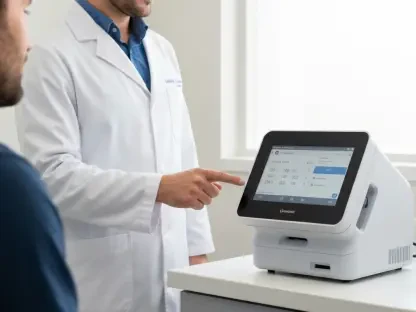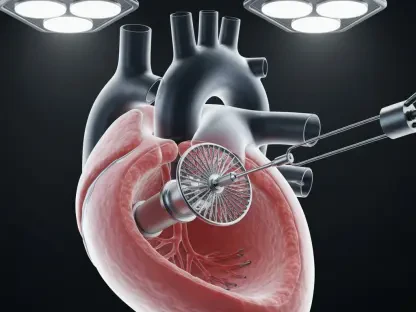What if a small device on your wrist could sense stress brewing inside you before your mind even registers the tension? In a society where burnout and anxiety often strike without warning, cutting-edge wearable technology is stepping in to offer a glimpse into the body’s hidden stress signals. This isn’t science fiction—it’s a reality with devices like Stressomic, a microfluidic biosensor that analyzes sweat to track stress hormones in real time. This article explores how such innovations are poised to transform the understanding and management of stress, potentially alerting users to emotional strain before it becomes overwhelming.
A Silent Warning System for Hidden Stress
Picture a hectic workday where deadlines loom, yet no physical signs of stress—like a racing heart or sweaty palms—have surfaced. Beneath the surface, however, stress hormones are already spiking, and a tiny wearable patch could detect this shift long before the body or mind reacts. Stressomic, a groundbreaking biosensor, operates by capturing sweat and analyzing it for biochemical markers like cortisol, offering a window into stress levels with startling accuracy. This technology promises to act as an early warning system, flagging emotional strain before it disrupts daily life.
The implications of such a device are vast, especially in a world where stress often goes unnoticed until it’s too late. Unlike traditional methods that rely on subjective feelings or delayed lab results, this wearable delivers real-time data directly to a connected app. It’s a shift toward proactive mental health care, where silent biochemical changes can be addressed before they escalate into full-blown anxiety or burnout.
The Urgent Need for Advanced Stress Detection
Stress has become a pervasive health crisis, silently fueling conditions ranging from cardiovascular issues to severe mental health challenges. Statistics paint a grim picture: workplace burnout affects millions globally, with many unaware of the toll until physical or emotional collapse occurs. Current tools, such as self-reported surveys or basic heart-rate monitors, often fail to capture the nuanced layers of stress, leaving a critical gap in early detection.
This is where advanced wearables step in, addressing a pressing demand for deeper insights. By tapping into the body’s hormonal responses through sweat analysis, devices like Stressomic provide a more comprehensive view of stress than ever before. This technology isn’t merely about tracking numbers—it’s about preempting crises, offering a lifeline in high-pressure environments where well-being hangs in the balance.
Decoding the Body’s Stress Signals with Cutting-Edge Tech
Stressomic stands apart from typical fitness trackers with its sophisticated design tailored to read the body’s biochemical language. Built on a flexible circuit board, it employs microfluidic channels to collect sweat and electrochemical sensors to measure hormones like cortisol and epinephrine every six minutes. This creates a dynamic timeline of stress responses, revealing patterns that traditional methods miss.
What sets this wearable apart is its ability to distinguish between different stress triggers. Human trials have demonstrated its precision: physical stress from intense exercise shows a rapid cortisol spike, while psychological stress from anxiety-inducing scenarios elevates norepinephrine levels. These real-time, non-invasive insights bypass the need for invasive blood tests, making the technology practical for everyday settings like offices or gyms.
Moreover, the data it provides is actionable and personalized. Studies have uncovered unique hormonal patterns across individuals, suggesting that stress responses vary widely. This opens the door to tailored interventions, bridging the gap between vague metrics and specific, immediate feedback that can guide stress management strategies.
Voices from the Field: Insights and Experiences
Behind Stressomic’s innovation are researchers like W. Gao, who highlight its potential to redefine mental health monitoring. “Most tools miss the intricate dance of stress hormones—this device captures a multi-biomarker snapshot as it happens,” they explained in a published study. Backed by machine learning models with an 86% accuracy rate in predicting anxiety, the technology’s credibility is reinforced by rigorous testing and detailed analysis of how each hormone contributes to emotional states.
Real-life stories from early testers add a human dimension to the data. During a psychological stress test, one participant was unaware of rising anxiety until the app displayed a sharp norepinephrine spike, prompting a moment of pause and reflection. Such experiences underscore the wearable’s ability to forewarn, turning abstract numbers into meaningful alerts that resonate on a personal level.
These combined perspectives—from scientific rigor to user impact—paint a compelling picture. The technology not only measures stress but also empowers individuals with foresight, validated by both empirical evidence and lived experiences. It’s a tool that bridges the lab and the real world, offering hope for more informed mental health care.
Empowering Action: Using Wearable Tech to Manage Stress
Beyond simply detecting stress, Stressomic equips users with practical ways to respond before tension spirals out of control. Its mobile app, connected via Bluetooth, allows monitoring of hormone levels during critical moments—be it a high-stakes meeting or an intense workout. If a cortisol surge appears, a quick breathing exercise could be initiated to calm the system, guided by real-time feedback.
Experimentation becomes a powerful ally with this technology. Users can test stress-relief methods, such as dietary supplements like taurine, and observe how hormone levels shift, customizing approaches that suit individual needs. Additionally, personalized alerts can be set to signal rising anxiety patterns, providing a crucial window to step back or seek support before feeling overwhelmed.
Collaboration with professionals further enhances its utility. Sharing stress hormone timelines with therapists or doctors can lead to more targeted mental health strategies, especially since trials indicate potential for clinical applications. This transforms raw data into a personalized “stress dashboard,” enabling proactive steps uniquely aligned with each user’s physiological responses.
Reflecting on a Game-Changing Innovation
Looking back, the emergence of wearables like Stressomic marked a pivotal shift in how stress was understood and managed. The ability to detect hormonal changes before they manifested as conscious tension offered a new layer of self-awareness, empowering countless individuals to intervene early. This technology didn’t just measure—it anticipated, reshaping the landscape of mental health care with precision and personalization.
As this field continues to evolve, the focus must remain on accessibility and refinement. Ensuring such devices reach diverse populations and addressing production consistency will be key next steps. Moreover, integrating these tools into broader health systems could amplify their impact, offering a blueprint for preventing stress-related crises on a global scale. The journey that began with a small patch on the skin holds promise for a future where emotional well-being is no longer left to chance.









